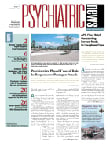American Airlines flight 77 crashed into the southwest side of the Pentagon on the morning of September 11, 2001, killing 189 people on the plane and in the building.
The terrorist attack was an echo of the ones on New York's World Trade Center the same morning.
Adm. John Mateczun, a psychiatrist who now spearheads the expansion of military health facilities in Bethesda, Md., was at the Pentagon on September 11, 2001. He went to the clinic to help care for burn victims, staying at the Pentagon through the night of September 11 and into the next day to provide support for firefighters and others.
Another psychiatrist, Army Lt. Col. Elspeth Cameron Ritchie, was at the Navy's Bureau of Medicine in Washington, D.C., across the Potomac River from the Pentagon.
"We saw it right after it was hit," she recalled in a recent interview. "Cars were still going around the Pentagon. Smoke was starting to billow up. It was surreal."
Told to evacuate, she headed for Walter Reed Army Medical Center in northwest Washington, D.C.
"I was assigned to help plan the mental health response to the disaster," she said. "For the next three weeks, I worked all around the Pentagon."
The Pentagon's DiLorenzo Clinic became the headquarters for medical and mental health personnel working in the building. (Incredibly, not long before, the clinic had held a disaster drill that assumed a plane had crashed into the Pentagon.)
Mental health workers of various kinds soon coordinated an outreach program, walking the halls, conducting group meetings—although not using formal critical-incident stress debriefings. More often, "therapy" consisted of informal chats with employees.
Ritchie also helped to set up a family assistance center at a hotel not far from the Pentagon in Arlington, Va., to serve all the armed services, as well as the families of victims on the planes targeted at Washington, D.C.
That was a learn-as-you-go task, she said. "There was no manual on how to set up a family assistance center."
Each family was assigned a casualty assistance care officer. A variety of social, legal, and mental health services were available for victims' families.
Army Surgeon General Lt. Gen. James Peake next asked psychiatrists, psychologists, and social workers on his staff to develop a behavioral health outreach program, called Operation Solace. The team drew on the lessons learned from the Oklahoma City federal building bombing in 1995.
Beginning in December 2001, 90 mental health specialists and chaplains worked throughout the Pentagon, running psychoeducation classes, therapy sessions, and group debriefings. Their goal was to reduce stigma by bringing care to those who needed it rather than waiting for them to come in the clinic door.
The civilian side of Washington's psychiatric community took action as well— or at least tried to.
Members of the Washington Psychiatric Society who wanted to volunteer found themselves in uncharted territory, said Catherine May, M.D., a private practitioner in Washington, D.C.
"They figured people would have trouble processing the event and so decided to offer free group sessions at rented conference rooms in area hotels in the District of Columbia, Maryland, and Virginia, but nobody showed up," said May in an interview with Psychiatric News.
Later, society members offered free one-hour sessions to individuals with an option to refer them for longer-term follow-up, an approach that proved more successful.
"Psychiatry was as unprepared as everybody else," said May. "We, too, were caught off guard. We, too, had to learn how to mobilize, how to anticipate what services would be needed, and how to deliver them. It was a trial-and-error process. Fortunately, we learned from our mistakes."
Tragedy in the Washington area didn't end with the attack on the Pentagon, May recalled.
A month afterward, someone began mailing powdered anthrax to addresses in Washington, D.C., New York, and Florida. Two workers in the main D.C. postal facility died from anthrax infection. Then, a year later, two snipers terrorized the capital and surrounding counties for three weeks, killing 10 people and wounding three others.
"The 9/11 attacks, the anthrax scare, and the sniper attacks, not to mention the war in Afghanistan in response to September 11 and the later invasion of Iraq, set up a series of repetitive traumas for many living in the Washington area," said May.
On the one-year anniversary of September 11, the Washington Psychiatric Society and the District of Columbia Medical Society presented the conference "Resilience in the Face of Terror" for psychiatrists and mental health professionals, said Eliot Sorel, M.D., who helped organize the conference.
"Disaster psychiatry is now an accepted part of training, practice, and research," said Sorel in an interview. "Psychiatrists have a leadership role to play in the response to such events because of their special understanding of the brain and human behavior."
One lesson from September 11 was that the mental health response to disasters should be integrated with that of other medical services, said May.
"Psychiatry shouldn't be stuck on mental health teams separated from everyone else in some place where nobody's going to show up," she said. "We need to be in the house of medicine."
Mateczun, too, drew lessons from the day's events: "Think about the unimaginable and be prepared to adjust and react when the worst happens."
Footnotes
This article is part of a series on 9/11 that began in the August 19 issue.

